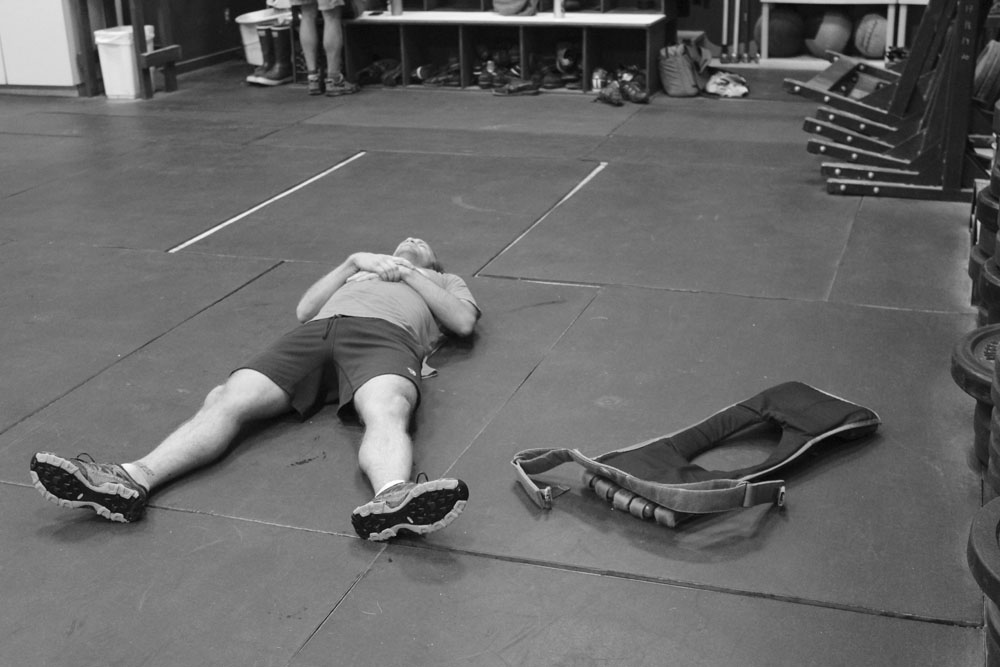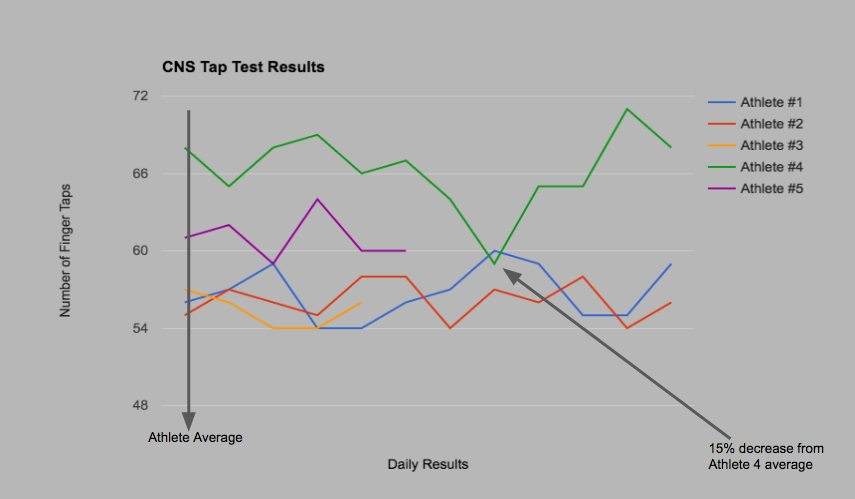
By Charles Bausman
Overtraining in the gym or in an athlete’s specific sport will lead to reduced performance across all facets of the body’s athletic function. Mitigating the risk of overtraining while continuing to program for physical development is a challenging task to balance for athletes and coaches alike.
Sports scientists have had good effect on detecting overtraining by monitoring an athlete’s Heart Rate Variability (HRV), which is the time gap between heartbeats that varies as you breathe in and out. When the HRV drops, it is likely symptomatic of overtraining.
Unfortunately, the real-world implementation of daily HRV monitoring isn’t realistic for our athletes. Dr. Kevin Serre, who works with Canadian SOF units, recommended the Central Nervous System (CNS) Tapping Test as an easier, more functional method of detecting CNS fatigue and in turn, overtraining.
With this easy to use test (explained later), we decided to implement the Tapping Test with our Lab Rats. What we hoped to determine was twofold:
- Is the CNS Tapping Test an accurate measurement to determine fatigue and overtraining?
- If so, can we develop a matrix based on Tapping Test results to scale our athlete’s training or prescribe additional rest from the gym?
The results of our mini-study seem to indicate that the Tapping Test is a viable method, but further observation is required to ensure it’s accuracy. Once a wider range of test results are collected, we can cross-analyze Tapping Test results and gym-based performance to develop a way to properly scale training sessions as required.
What is the CNS?
The Central Nervous System (CNS) consists of the brain and spinal cord utilizing neurons to send various signals to the rest of the body. It processes sensory input and motor output, essentially controlling all of the body’s basic functions.
A simple example of the CNS function is the reflex test. A doctor will tap your knee with small rubber hammer on your knee while dangling it over a table, and your knee involuntarily reacts to the stimuli by jerking slightly.
It serves as a method to test the reaction time between the sensory input (tapping the knee) traveling to spinal cord and brain, and then back to the leg in the form of motor output (knee jerk). This motor division carries the signal from the CNS to cells in the body to carry out the body’s response to the sensory information.
The function of the CNS is critical to movement and strength, and just like a muscle, it can fatigue if not properly recovered. Poor sleep, poor nutrition, and over-training are believed to be significant contributors to temporarily reducing CNS function levels.
How It Relates to Training
Academic study of CNS fatigue due to strength and conditioning training is fairly new and underdeveloped. A critical literature review by Dr. Batson on the topic simply states “knowledge is lacking as to the precise factors that underlie fatigue and limit performance in a variety of types of exercise”
Possible explanations are the release of ammonia (a neuromodulator released by neurons) during exercise, accumulated into the blood and brain during exercise, negatively affecting CNS function. The increase of cytokine secreted by cells may also be indicative of CNS fatigue, but the research has not been able to fully establish either of these theories.
From a training perspective, decreases in CNS function have been attributed to maximal strength training, aerobic endurance training, and anaerobic energy system training. When put in context of most functional fitness training methodologies, everything we do for training may lead to CNS fatigue, and therefore reduced performance.
While the true causation for CNS fatigue may be undefined at this time, methods of measurement do exist which have been developed which claim to directly correlate to performance.
The tapping test, a handgrip dynamometer, and vertical jump are all relatively simple methods for measuring the function of the CNS as it relates to athletic performance. Each involves a fairly simple process of determining the athlete’s average for the respective test, and testing the athlete prior to each training session. If the athlete’s results are significantly inferior to his or her average, it is likely a sign of CNS fatigue and overtraining.
Other non-training factors can alter the results. Low-motivation, personal-psychological issues, and drug or alcohol abuse may cause lowered results. Inversely, stimulants such as caffeine in coffee or pre-workout powder can artificially increase results.
CNS Tapping Test Mini-Study
Over a period of four weeks, we conducted a preliminary study to see if the relationship of the Tapping Test, a proposed method of measuring CNS function, equated to gym-based performance.
Each athlete downloaded The Finger-Tapping app and conducted the test prior to each training session. The athlete completes three rounds of 10-second max finger taps with their dominant hand onto their smartphone. The app provides the average of the three rounds, which serves as the score for that day. The first week of training was used to determine their average so that we could compare those results to the following training days.
As outlined previously, a significant drop should hypothetically be indicative of CNS fatigue. As coaches, this could provide a solid metric to base a decision on whether to scale the athlete’s workout, send them home, or allow them to train as prescribed.
Several factors were involved which did not allow for ideal testing. Massive snowstorms hit the Jackson area, which temporarily closed down roads and precluded athletes from getting to the gym. Two athletes went on vacation and results were incomplete. Additionally, all of our athletes are active in the mountains skiing in conjunction with physical labor jobs on a day to day basis.
Regardless, we did observe an interesting trend. As you can see in the chart below, one athlete experienced a 15% decrease in his tap test results. During this time, he had experienced a minor hip flexor injury that was affecting his gym performance. We scaled his training in order to allow the injury to heal.

It’s interesting to note that not only did his Tap Test results appear to correlate to the injury, it also improved after a few days of scaled-down training.
These initial observations would seem to encourage the positive correlation between the Tapping Test and CNS fatigue. It is impossible to know whether the athlete’s injury was due to CNS fatigue, or the injury decreased CNS performance.
The other 23 hours of the day outside of the gym were not controlled and certainly could have played a part in the decrease, and following increase.
Regardless, we think that the Tapping Test may be a valid method to predict performance and enable better coaching for any given training session.
With the baseline test established, we hope to continue this study over a longer duration with the following goals in mind.
- Establish a protocol to scale training sessions based on Tapping Test results
- Engage a better recording system to track sleep habits, nutrition, and outdoor-related activities which may influence results
- Test Tappng Results on seriously injured athletes in the post-op recovery stage
- Determine Tapping Test change after hard gym training sessions which involve 90% 1RM load or more, endurance, and work capacity
Questions? Email coach@mtntactical.com
Comments? Please enter your comment below.
Sources
- J Mark Davis, Nathan L Alderson, and Ralph S Welsh, Serotonin and central nervous system fatigue: nutritional considerations
- Davis JM, Bailey SP. Possible mechanisms of central nervous system fatigue during exercise. Medicine and Science in Sport and Exercise. 1997 Jan;29(1):45-57.
- Le Meur, Pinchon, Schaal, Lous, Gueneron, Vidal, Hausswirth Evidence of Parasympathetic Hyperactivity in Functionally Overreached Athletes – Medicine Science Sports Exercsise 2013 May 14Ryan Donahue, A Review of Central Nervous System FatigueBrendon Johnson, Correlation between Heart Rate Variability and Tap Test for Determining Exercise Preparedness, California University of Pennsylvania
- Davis JM. Alderson NL, Welsh RS. Serotonin and central nervous system fatigue: nutritional considerations. American Journal of Clinical Nutrition. 2000 August; 72(2 Suppl): 573S-8S
- Glenna Batson, Exercise-Induced Central Fatigue: A Review of the Literature with Implications for Dance Science Research
